#baru huberi
Text
The NEW Ultrastenos and its Ironic History
So those that have been keeping up with my posts on mekosuchines might recall the name Ultrastenos, as I've talked about this genus back in August of last year. If you've read that post you might also remember how I highlight at multiple points that a lot of the info was tentative on the basis that Ultrastenos was highly incomplete and that close relatives awaited description.
You may also remember "Baru" huberi, a small mekosuchine that lived roughly around the same time, clearly distinct from Baru yet at that point still unnamed. Oh, how I wished for the former to get more material and for the latter to recieve a proper genus assignment.
My now outdated reconstructions for "Baru" huberi (the small one in the left image) and Ultrastenos (right image)

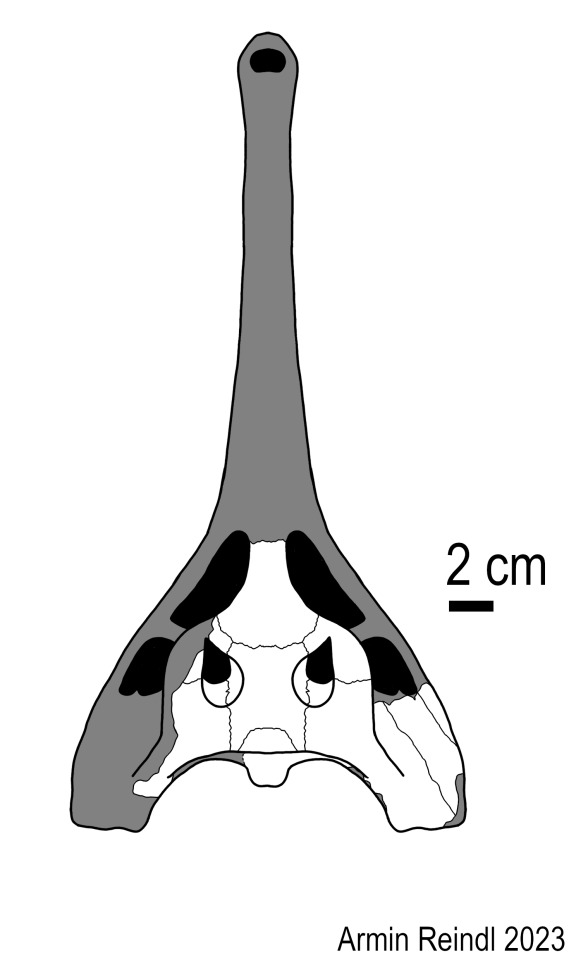
And then the monkey's paw curled.
As it turns out....they are the same damn animal.
Now, back when "Baru" huberi was described, Willis also named a bunch of other mekosuchines from the same locality (the White Hunter Site of the Riversleigh WHA) and described even more material that remained unnamed, including the White Hunter Cranial Form 1. Now, when Ultrastenos was named in 2016, the type material was from the Low Lion Site (also Riversleigh), but importantly, the skull tables identified as WHCF1 were also assigned to the genus (and were the basis for my reconstruction).
Well, re-examination has shown that the WHCF1 and the holotype of "Baru" huberi aren't just a single species.....THEY ARE A SINGLE INDIVIDUAL.
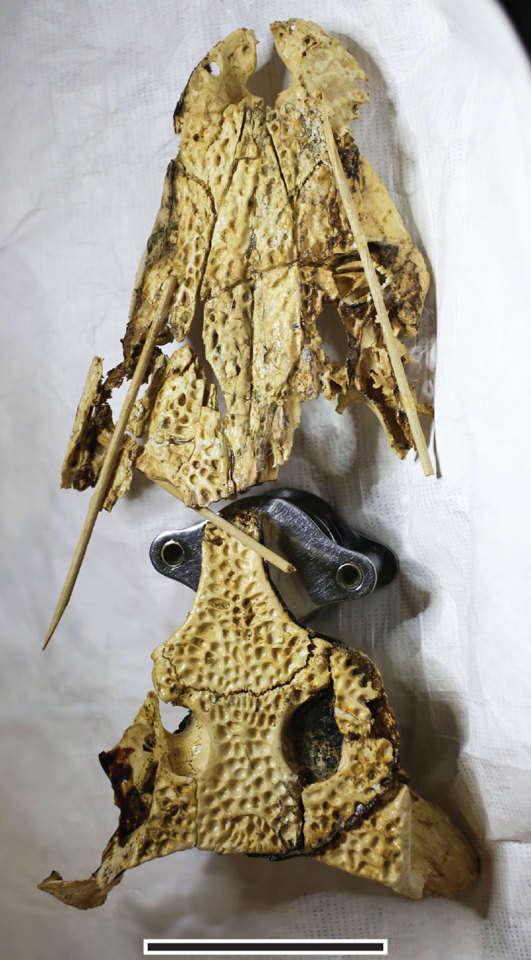
Given the fact that the assignment of the skull table to the Low Lion Ultrastenos material still holds up, this means that Ultrastenos willisi and "Baru" huberi are a single taxon. Which consequently requires some reshuffling of the names.
"Baru" huberi was named first, so the species name takes priority and continues being used. However, since it was never given a genus name, Ultrastenos does stay valid. Except now it's called Ultrastenos huberi, not Ultrastenos willisi.
A name that has aged like milk. Back in 2016 it was proposed that Ultrastenos had a very narrow snout (thus the name), so now that we know that the rostrum was flat and mesorostrine, the name really is just wrong.
So next up, lets examine what went wrong.
As I said before, Ultrastenos was fragmentary, so that certainly played a big part in it. But the team in charge of describing the animal still cited several lines of thinking to support their interpretation, most of which are now thoroughly debunked.
As an example, the lower jaw was rather shallow, however while this was initially taken as evidence for longirostry, the 2024 paper states that this only an argument against altirostry (a deep skull), not against a more generalized condition. The teeth were also initially used as evidence, citing their homodont condition (the teeth looked uniform), HOWEVER, the problem in that was that there were only a few teeth present, all of which notably do not bear any resemblance to the needle-like teeth seen in other long-snouted taxa. Another important clue initially taken to mean longirostry was the orientation of the quadrate area and the seemingly sudden constriction of the lower jaw. But the quadrate area was not found in articulation and would support a generalized skull form if simply rotated a little, while the constriction of the mandible appears to at least be partially exaggerated by preservation.
Of course, the fact that we now have proper material of the snout makes the interpretation of a generalized skull shape a lot more solid.
Image 1: The left and right halves of the mandible of Ultrastenos compared to that of Baru iylwenpeny (D), note how the right half is a lot more straight.
Image 2: The initial reconstruction of the quadrate area of Ultrastenos compared to one that is slightly rotated
Image 3: The revamped skull reconstruction by Yates and Stein

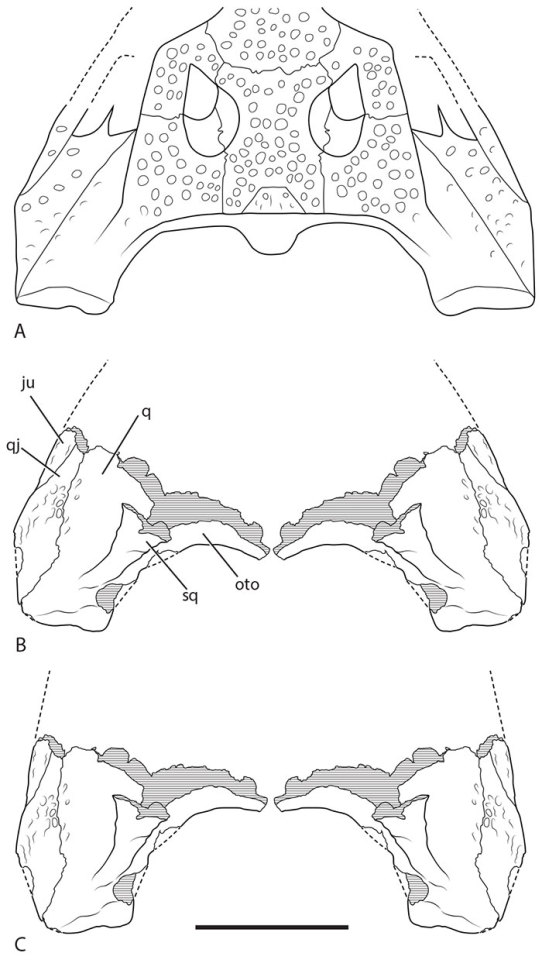
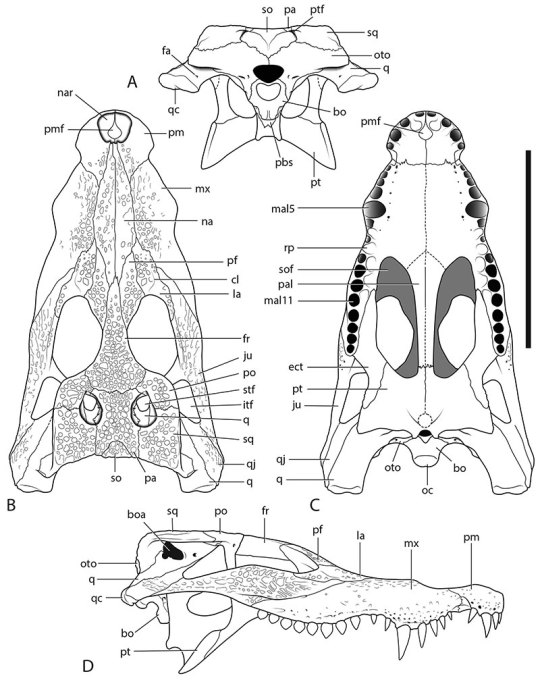
The size of the animal does stay relatively unaffected by these new discoveries. "Baru" huberi has been estimated at only around 1.5 meters in length and my own scaling of Ultrastenos got up to 2 meters, which seems to be in line with what is still assumed for this animal. So among aquatic mekosuchines, its still rather small.
There are however some interesting implications for mekosuchines at large. Now that we no longer have a longirostrine member of this family, one has to wonder, why is that?
Well, there might be several reasons.
It could be that the types of environments that were present in Cenozoic Australia simply didn't support such animals. Even in the type description, its been noted that the Riversleigh isn't exactly known for its fish remains, leading to the idea that Ultrastenos might have gone for other small vertebrates like frogs. Hell, the ecology of Baru might suggest that the reason that this genus was so robust might tie to the fact that the local bodies of water just weren't deep enough to allow the typical crocodilian grab-and-drown tactic.
Competition might have been another factor. In environments that may have been more suitable for such morphology, mekosuchines might have been beaten to the punch by other types of crocodilians. Harpacochampsa for example, tho originally thought to be a mekosuchine, is now more often regarded as either an unrelated crocodile or a gharial and its very possible that it filling the nische of a longirostrine simply meant that mekosuchines didn't have the opportunity to expand into that space. Same goes for Gunggamarandu in the Pliocene and Pleistocene and Freshwater Crocodiles from the Pleistocene onwards. (Tho it should be noted that both Harpacochampsa and Gunggamarandu are so fragmentary that their snout shape is technically unknown).
Images: Gunggamarandu (Eleanor Pease), Harpacochampsa (ArtbyJRC) and Freshies (Antoni Camozzato) might have been key factors in why mekosuchines never evolved slender snouts.
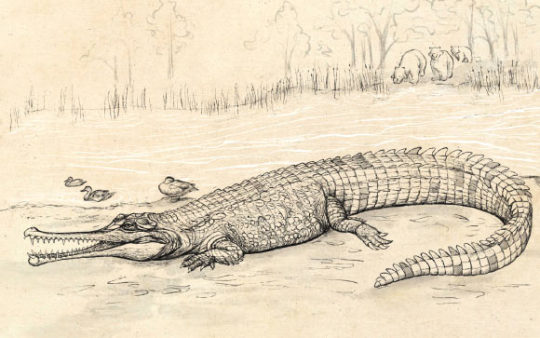
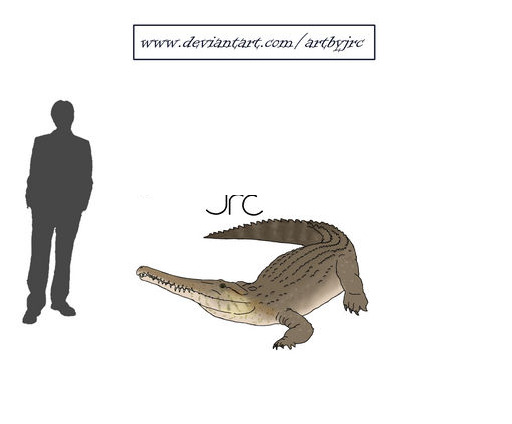
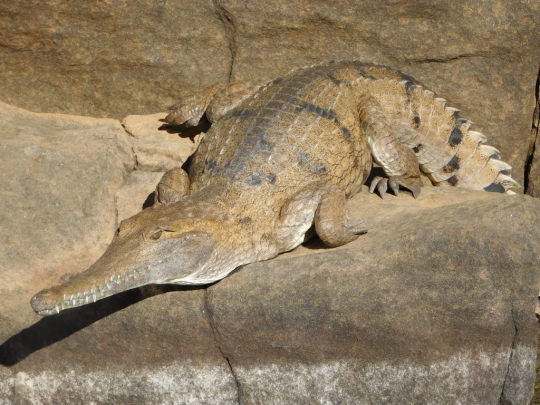
Finally, its also possible that something in the growth of mekosuchines simply prevents them from evolving longirostrine skulls, which Yates and Stein liken to alligatoroids (notably the closest alligatoroids got to traditional longirostry as seen in gharials is the Rio Apaporis Caiman, and even that one is closer to some extant crocodiles in its morphology).
Whatever the case, I for one mourn the loss of our long-snouted Ultrastenos. Tho as a note for any paleoartists, there is not a single illustration of this new interpretation since nobody ever drew "Baru" huberi either. Wink wink nudge nudge
Links:
https://en.wikipedia.org/wiki/Ultrasteno
Ultrastenos revised (palaeo-electronica.org)
#long post#harpacochampsa#ultrastenos#baru huberi#mekosuchinae#gunggamarandu#oligocene#riversleigh#paleontology#palaeoblr#croc#crocodile#crocodilia#prehistory#cenozoic
44 notes
·
View notes
Text
Baru: The Cleaver-Headed Crocodile
Ok back on my croc stuff, today discussing Baru. Like most the other crocs I've been talking about, Baru was a mekosuchine, a member of an endemic radiation of crocodilian native to Australasia.
Baru is easily among the largest of this group and among the most robust, with massive curved teeth and almost inflated looking jaws.
Left my interpretation of Baru darrowi, right the illustration by Willis et al. from 1990.
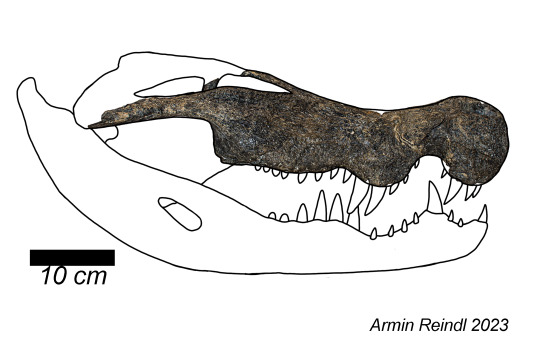

My reconstruction differs subtly in some regards, obviously the jaw material shown is from Ristevski et al. 2023 and elements of the posterior skull are based on the older Baru wickeni. My mandible also turned out slightly different, tho the quality of the images in the original description is not great so that is not guaranteed.
Anyhow, this head likely sat atop the body of what was a decently large crocodilian, with estimates suggesting four or even five meters in length for both currently recognized species Baru wickeni and Baru darrowi. As you can see below, I went for the lower estimate (which is the one given by proper publications), which still renders an immense animal all things considered, certainly holding up with many crocs of today.

Currently, there's two recognized species, one unnamed species and one that has been reassigned. The older of the named species is Baru wickeni, which was found in the Lake Eyre Basin and Riversleigh World Heritage Area during the late Oligocene. Like I already said, it was approximately as large and robust as the later Baru darrowi, but did differ in some regards. The skull had much more prominent crests, the nasal bone extended into the opening for the nares and importantly, the cutting edges of the teeth were smooth.
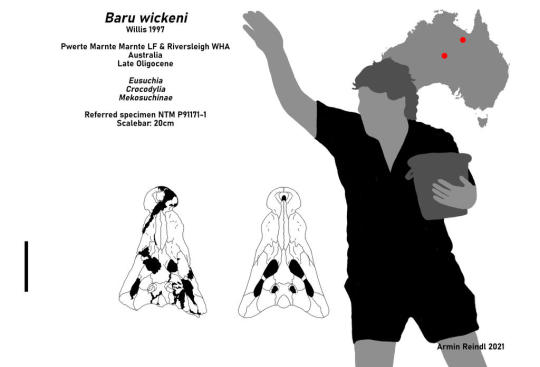
During the Miocene, Baru wickeni would be replaced by Baru darrowi, known from younger strata of the Riversleigh and the Bullock Creek fauna. Baru darrowi had less prominent crests, but in turn slight serrations on its teeth. Also the nasal bones did not extend into the nares. Baru darrowi is the species shown at the start.
The other two are then the unnamed Baru species from the Alcoota fossil site and "Baru" huberi. I talked about the latter before and how it is now thought to be something else entirely. Which leaves us with the Alcoota form. Generally regarded as a distinct species, fossils of the Alcoota Baru have been found from 2000 onwards near Alice Springs and appear to represent an animal more robust than the other known Baru. Below you can see a skeletal mount on exhibition at the Megafauna Central in Alice Springs (image by Aussie Bucket List) and a skull held by Adam Yates, an important researcher of this animal.
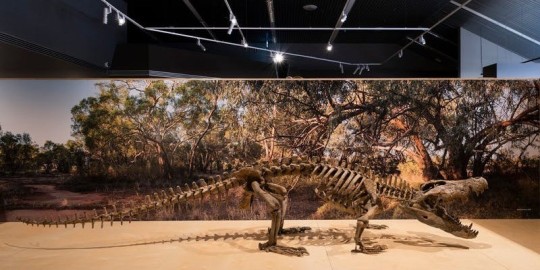
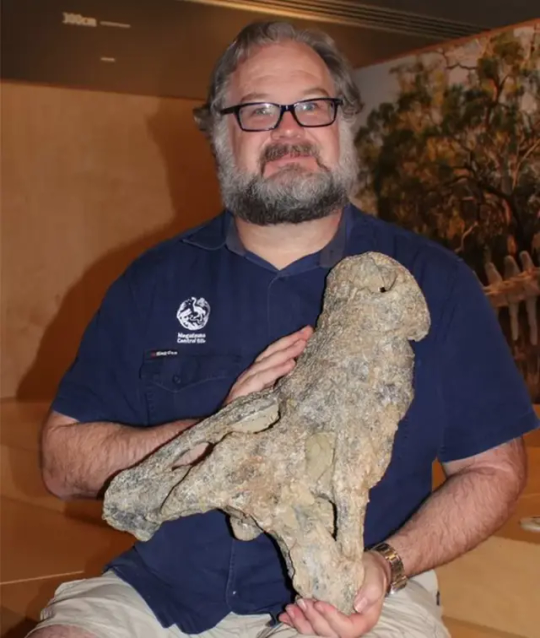
A little side note I want to mention is the name Baru. As you might have guessed from the etymology of various other mekosuchines (Kambara, Mekosuchus, Quinkana, Kalthifrons), the name actually ties into the native People of Australia. Specifically, Baru is a figure in the mythology of the East Arnhem Region, which describes him as a sort of totem crocodile that brought law to the lands he named. Baru also had a fight with Jarkitj (Willy Wagtail) after stealing fire for himself. Sadly I couldn't find much about the mythical Baru beyond a brief summary written up by George Pascoe Gaymarani you can read here.
Returning to the animal, one would suspect that the robust skull meant that it didn't quite hunt like modern crocodiles, especially considering the serrated teeth found in the younger species. Well, tho nothing concrete is known Willis and colleagues speculate that this might have been an adaptation to shallower waters. While modern crocs tend to ambush prey, grab it using a strong bite and conical teeth and then proceed to drown it, Baru may not have had that option. A modern croc can just drag a zebra for instance into deep water, weaken it and let go to adjust its grip without the risk of it getting away. In shallow waters, this may have been too risky and lead to prey escaping. So Baru's robust head and curved, sometimes serrated teeth were built to inflict a lot of damage upon prey when lunging, securing the bite and incapacitating it. Willis estimates that it may have taken prey as heavy as 300 kilos.
There's also the interesting tidbit of Baru wickeni coexisting with a diverse croc fauna, yet being conspicuously absent from more southern regions of Australia despite entering the respective drainage basin. I go into more detail while talking about Australosuchus, but the jist of it is that Baru was likely not as cold resistant as Australosuchus and thus not found as far north.
Alas, as with other mekosuchines, not much art of Baru exists aside from this absolutely fantastic piece by @knuppitalism-with-ue
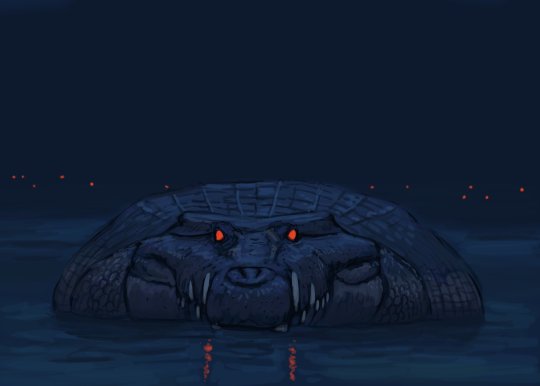
As per usual, this deep dive is brought to you as part of me redoing the wikipedia page of this genus, which resulted in a major size increase. The image below is just to show the difference, but if you want to read it here's the link: Baru - Wikipedia
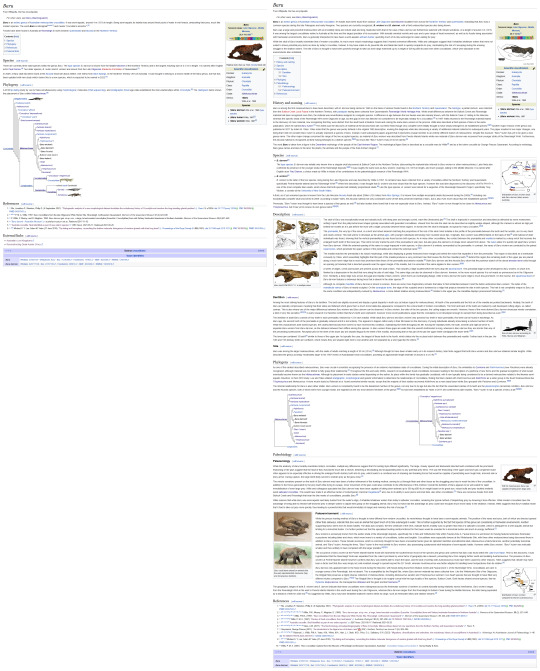
#mekosuchinae#wikipedia editing#wikipedia#baru#baru wickeni#baru darrowi#baru huberi#croc#crocodile#paleontology#palaeoblr#prehistory#oligocene#miocene#australia#long post
115 notes
·
View notes
Text
"Baru" huberi
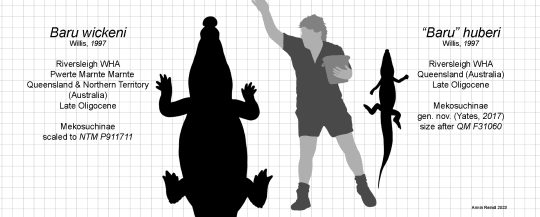
Baru is a genus of decently big mekosuchine crocodilian from the Oligocene and Miocene of Australia. The two currently accepted species, Baru wickeni and Baru darrowi, clock in between 4 to 5 meters, which puts them in a range not dissimilar to today's niles and salties.
But when Baru wickeni was named in 1997, a third species was also coined. Baru huberi, simply described as having been "much smaller"
Having started working on the wikipedia page for Baru recently, I did get curious to see how much smaller and well the results are....I mean "much smaller" seems like an understatement to me. Baru wickeni, which lived in the same area and at the same time as "Baru" huberi, dwarfed the other mekosuchine. Which brings us to "Baru" huberi's TRUE identity.
You see, tho named as a species of Baru, mekosuchine research has been mostly confied to the last 30 years and this paper came fairly early on in our understanding of the group, Naturally, things move around and change, as was the case for "Baru" huberi. Nowadays, researchers agree that "Baru" huberi is not a species of Baru. No, instead "Baru" huberi was a distinct genus seemingly more closely related to animals like Trilophosuchus or Mekosuchus and thus should get a new name.
That...obviously didn't happen yet but we'll get there eventually. Just gotta give it some more time. Meanwhile, I tried my hands at reconstructing the animal behind the name.

The grey area marks the big unknowns in "Baru" huberi, all the stuff we don't know. I based my interpretation primarily on Trilophosuchus, the best known member of this branch. On the left, you see the sympatric Baru wickeni. It's an older illustration of mine, but one that should mostly hold up.
Baru huberi - Wikipedia
The biochronology and palaeobiogeography of Baru (Crocodylia: Mekosuchinae) based on new specimens from the Northern Territory and Queensland, Australia [PeerJ]
New crocodilians from the late Oligocene White Hunter Site, Riversleigh, northwestern Queensland (biostor.org)
#baru#baru wickeni#baru huberi#“baru” huberi#mekosuchinae#oligocene#australia#croc#crocodile#crocodilia#herpetology#herpblr#palaeoblr#paleontology#prehistory#skeletal#pseudosuchia
93 notes
·
View notes
Text
Baru iylwenpeny: The Last Baru
Happy to announce that there's just been a major new publication for mekosuchines. The Alcoota Baru, which I briefly touched upon in my post on the genus, has finally been named.
The new name, Baru iylwenpeny (pronounced eel-OON-bin-yah), derives from the Eastern Anmatyerr dialect (part of the Arrernte language) and means "good at hunting". A name that seems quite fitting when you look at the skull.
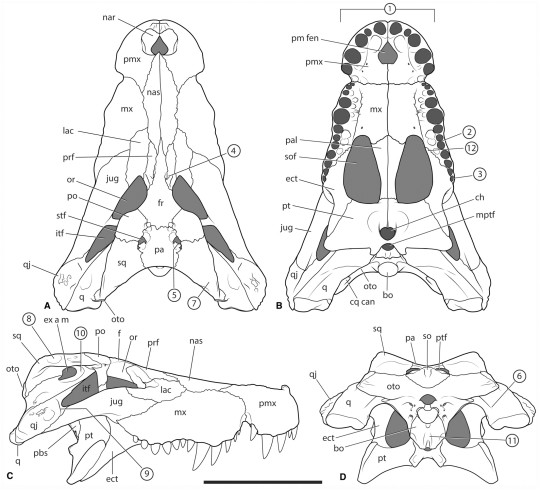
As a reminder, this animal stems from the Alcoota Fossil Site in Australia and dates to the Late Miocene, making it the youngest of the three recognized Baru species.
Previously this species was already referred to as being "the most robust Baru" and they weren't kidding. This thing looks more like something out of the Cretaceous than an animal that lived a mere 8 million years ago.
The morphology is interesting in many ways. Many of the ridges that are so prominent in Baru wickeni and less developed in Baru darrowi are absent. The seventh and eight tooth are so close they theres basically no space. Instead of four teeth like other Baru it has five in each premaxilla and the nasals reach the nares, like in Baru wickeni but unlike in Baru darrowi. The teeth also show the same small serrations as Baru darrowi and, unlike either of the other species, the jaws appear much less wavy not because they are but because the first festoon of the maxilla is followed up by a second one so developed it makes the first look almost flat.
It's a fascinating mosaic of characters that makes its relation to the other species a puzzling question. You'd think that the ridges for instance point at it being derived? After all wouldn't it make sense? Baru wickeni had the most developed rigdes, Baru darrowi smaller ones and Baru iylwenpeny none. Plus, the teeth of Baru wickeni are smooth unlike those of later forms. Yet at the same time....
The fact that it has five teeth instead of four and the fact that the nasals reach the nares are both ancestral traits, so you'd expect it to be closer to the base.
Left: Baru wickeni
Right: Baru darrowi
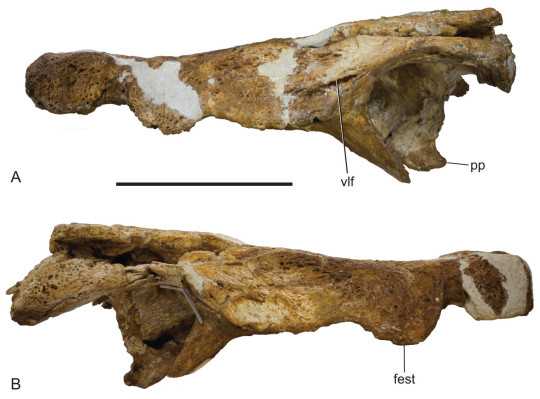
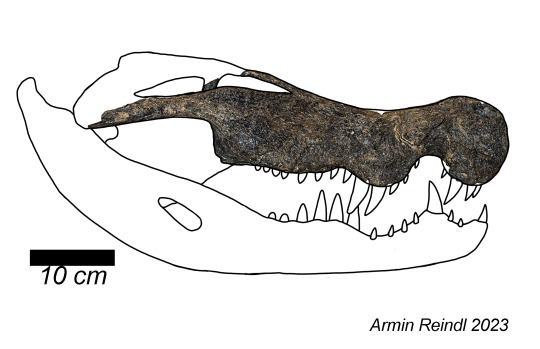
Well, while I think this isn't going to be the final place of this species among Baru, the most recent phylogenetic analysis suggests that Baru iylwenpeny was weirdly enough the basalmost species. Which means that it must have split from the other two species at the latest during the Late Oligocene and outlived the both of them without us ever knowing.
The paper also discusses how these animals may have gone extinct. If you look back at Kalthifrons, you might remember how I mentioned that mekosuchines kinda had a drop in diversity when transitioning from the Miocene to Pliocene. While the new paper avoids calling this a drop in diversity, it does highlight that there certainly was a turnover in fauna.
The reason is an old enemy of mekosuchines. Climate.
Yates and colleagues suggest that Australia was hit by an especially nasty dry period at the end of the Miocene, severe enough to drive Baru to its death but not severe enough to whipe out all mekosuchines. And after Baru was gone, Kalthifrons and Paludirex moved into the open niche.
There's also a final little piece of information that's not focused on yet really fascinating. Baru iylwenpeny had a friend. At least one other croc lived at the Alcoota site during the Late Miocene and tho it hasn't been studied in full yet, one thing is apparently known. It was a relative to the Bullock Creek taxon that coexisted with Baru darrowi and a relative to "Baru" huberi, the small croc that coexisted with Baru wickeni. This grouping has yet to be given a name, but its fascinating to me that each Baru species seemingly coexisted with a much smaller mekosuchine. Alas, like Baru this lineage seems to have fallen victim to climate change.
Baru wickeni and "Baru" huberi, in truth an unnamed genus.
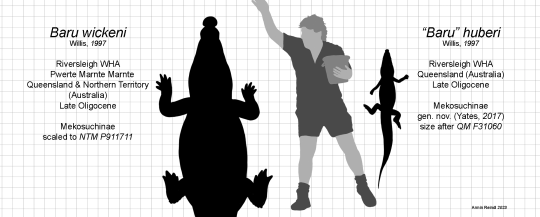
The paper is accessible here for those that wan't to dive deeper into the matter. I'll also be working on an updated size chart, this time featuring all three species of Baru, tho I can already tell you that despite being more robust its surprisingly not that much larger.
The last Baru (Crocodylia, Mekosuchinae): a new species of ‘cleaver‐headed crocodile’ from central Australia and the turnover of crocodylians during the Late Miocene in Australia (wiley.com)
#baru#baru iylwenpeny#alcoota baru#alcoota fossil site#miocene#paleontology#palaeoblr#crocs#crocodile#mekosuchinae#paleontology news#prehistory
95 notes
·
View notes
Text
Kalthifrons and the Fall of Mekosuchines
The penultimate singular mekosuchine I'll talk about here is Kalthifrons, one of the more obscure members of this clade. After all, Kalthifrons was named only in 2017 and unlike some other animals like Ultrastenos, it does not stand out as much morphologically. But I still wanna take a moment to talk about this medium-sized Pliocene croc, its potential fate and the implications for its relatives.
Left: The skull of Kalthifrons (Ristevski et al. 2023)
Right: A reconstruction of how the skull may have looked like intact


In many respects Kalthifrons looks very typical for a crocodilian, with a triangular head, rounded snout and eyes that face upwards. There are some interesting factors to mention, at least imo, and one thing thats sorta unknown. Starting with the unknown, what we aren't sure about is how deep the skull is. Sure the skull of Kalthifrons looks very intact in top view, but when looking at it from the side its about as flat as a sheet of paper. So we can't exactly tell how deep the skull would be. Maybe it was not much different from a modern croc...or maybe it was comparable to Baru the cleaver-headed crocodile. We simply don't know. The other two interesting things about its anatomy are more subtle. For one, the tip of the snout is comparably narrow. Now generally, if you look at mekosuchines the premaxilla and external nares tend to be wider than long, even in Australosuchus, but in Kalthifrons they are longer than wide. And then there's the frontal. The name Kalthifrons derives from the Latin word for forehead and the Dieri word for spear. The reason why is that the frontal bone, which covers the forehead, has an exceptionally long spear-like process at the front. Sure such a process is also found in other crocs, but in Kalthifrons it makes up 64% of this bones entire length.
A hypothetical reconstruction showing the size of Kalthifrons, which may have been around 3.4 meters.

With a length of possibly up to 3.4 meters and a triangular skull, Kalthifrons was probably a fairly generalist hunter. Fossils of Kalthifrons are known from a single place, the Golden Fleece Locality along the shores of Lake Palankarinna in the Lake Eyre basin, South Australia. Now this locality primarily yields two things. Croc fossils and turtles. Based on this and certain minerals in the sands of this locality, it has been suggested that the Golden Fleece Locality once housed a waterhole that dried up, leading to the deaths of its inhabitants.
The death of Kalthifrons as illustrated by Joschua Knüppe.
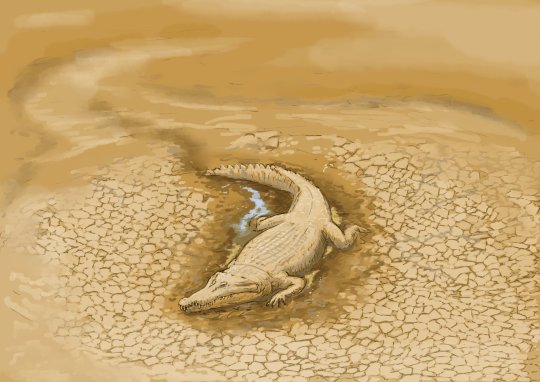
Which leads us to a bit of discussion regarding the general state of mekosuchines during the time of Kalthifrons. Now if you have read my previous posts on mekosuchines, you'll notice one thing. Most species native to continental Australia were around during the Oligocene to Miocene. Australosuchus, Baru, Ultrastenos, "Baru" huberi, Trilophosuchus and the continental Mekosuchus species. After the Miocene, continental species become rarer. Really you got Paludirex, Kalthifrons and Quinkana. And even they wouldn't stick around for much longer, with the last mekosuchines of Australia going extinct at the end of the Pleistocene.
So obviously mekosuchines experienced a drastic fall in diversity towards the end of the Miocene, clinging on for a few more million years before disappearing forever. But there's another thing that happened around this time. Modern crocodiles showed up. Contrary to popular belief, today's crocodiles of Australia are relatively recent arrivals. Freshwater crocodiles only lived there since the Pleistocene and saltwater crocodiles were likely even more recent, with both of them having evolved from different ancestors and arrived in Australia independently. But there's at least one more species of Crocodylus. The as of yet unnamed Tirari Desert Crocodile is known from remains that date to strata slightly more recent than that of Kalthifrons, displaying similar generalized anatomy. Like freshies and salties, the Tirari Crocodile arrived on its own, with phylogenetics indicating that its closest relatives were the palaeoafrican crocodiles like Crocodylus thorbjarnarsoni (a giant that grew up to 8 meters long).
Crocodylus species of Australia
Top left: The freshwater crocodile (Ristevski et al. 2023)
Bottom left: The saltwater crocodile (Ristevski et al. 2023)
Right: Stratigraphy of the Lake Eyre Basin and successions of local crocodilians (Yates and Pledge 2017)

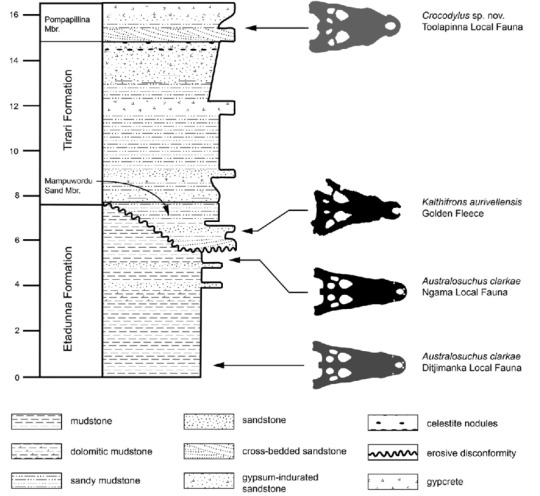
Did Crocodylus drive Kalthifrons to extinction? Well, maybe? Yates and Pledge discuss this possibility in the description of Kalthifrons, suggesting that theres some supporting pieces of information for this hypothesis. Not only does the arrival of the Tirari crocodile match up nicely with the disappearance of Kalthifrons, but they both share very similar anatomy. And conventional wisdom suggests that two crocs of the same morphotype don't really coexist in the same habitats.
But there's also points against that which aren't as openly discussed. Namely, the lack of material. Sure we have Kalthifrons in the older Mampuwordu Sand Member and the Tirari Crocodile in the younger Pompapillina Member, but remember. We only have that one Kalthifrons individual. We further know little about their habitat preferences. Sure conventional wisdom suggests crocs with similar morphology don't coexist, but that doesn't mean they don't overlap. Some species may very well be separated by the specific habitat they prefer. Slow open water, fast moving streams. Finally, is replacement necessarily the only answer? Not really. It has been deduced that Kalthifrons died in a drought and aridification is regarded as one of the main drivers of Australian megafauna extinction, as touched on in my summary of Paludirex. Maybe that's it? Kalthifrons was driven to extinction when environmental conditions grew too harsh, with Crocodylus entering the newly opened niche. This may parallel what happened in Miocene Africa, when rainforests disappeared osteolaemine crocodiles likely gave way to Crocodylus, which was better suited to the dryer climate.
Whatever the case, Kalthifrons is one of the most recent mainland mekosuchines and thus may be critical for us to determine what happened during this part of Australia's history. So sure it might not be flashy, but it's still an important little guy.
#mekosuchinae#kalthifrons#palaeoblr#prehistory#paleontology#pliocene#australia#croc#crocodilia#extinct#extinction#long post
90 notes
·
View notes
Text
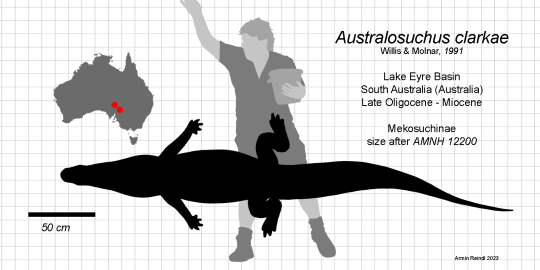
A comparably brief one this time, but this is Australosuchus. Australosuchus is yet another mekosuchine from the Oligocene to Miocene, roughly contemporary with "Baru" huberi from last time.
At around 3 meters long, its a medium-sized animal with a more or less generalist semi-aquatic bauplan known from plentiful remains all found in South Australia. And I do mean plentiful. We not only have many parts of the body, but plenty of specimens too.
Regarding its anatomy there's just one thing I wanna highlight which is the occlusal pit for the fourth dentary tooth. If you look at crocodile skulls, you'll often notice how the snout sorta constricts fairly early on. This is because the fourth tooth of the lower jaw neatly slides into this region. However, in Australosuchus this is less a notch or constriction, but a full on hole in the skull thats almost entirely enclosed. I just think thats neat.


Little is written about its biology, safe for one really fascinating thing. It's range. When looking at the fossil locality where the remains of this croc were found, you'll notice that it appears to be the only crocodilian around. By contrast, if you were to go to any locality in the north, like the famous Riversleigh WHA, you'll find a multitude of mekosuchine species of all shapes and sizes....yet no Australosuchus. For some time, it was suggested that there was simply a geographic barrier, a dessert perhaps. That the species in the north just couldn't reach the Lake Eyre Basin. But finds from Pwerte Marnte Marnte have shown that the northern forms, like Baru wickeni, were in fact present in the basin. So why not further south?
Well, Adam Yates suggests that latitude was the deciding factor. Yates argues that the species from the north like Baru were unable to handle the climate of southern Australia, which is why although present in the basin, Baru is not found anywhere below the 27° South. However, Australosuchus, which may have been more cold resistant (like modern alligators) was capable of surviving the lower temperatures, thus being the only crocodilian found in these southern waters during the Late Oligocene and Miocene. The whole thing is illustrated by Yates too for those who want a visual aid.
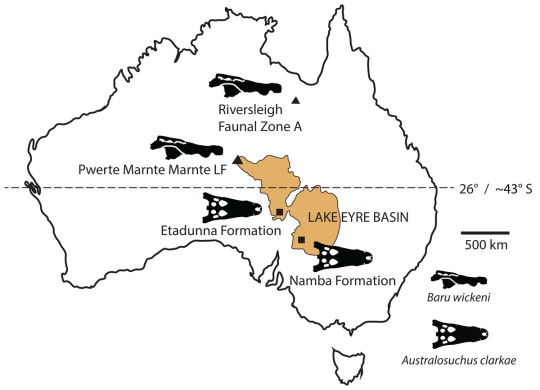
#mekosuchinae#australosuchus#baru#croc#crocodile#crocodilia#palaeoblr#paleontology#prehistory#herpetology#australia#oligocene#miocene
34 notes
·
View notes
Text
Ultrastenos: Narrow Snouted Mekosuchine?
So this one comes with a pretty big disclaimer. Ultrastenos, evenmoreso than any other mekosuchine, is incomplete and enigmatic. Whereas animals like Mekosuchus at least bolster a long research history or at least somewhat complete remains of specific body parts, Ultrastenos is both new and fragmentary. This, combined with ongoing research, means that this reconstruction is just a preliminary one based on current publications and should not be taken as gospel.


Ultrastenos is best known through assorted skull fragments and crania, notably part of the quadrate and quadratojugal, the occiput (back of the skull), an incomplete lower jaw, misc. postcrania like a tibia and vertebrae and some referred skull tables.
Already we enter some weirdness as the type material all stems from the Low Lion Site of the Riversleigh WHA, while the skull tables are from the White Hunter Site (also Riversleigh). Tho they are roughly of the same age, both being late Oligocene, but they are still different localities.
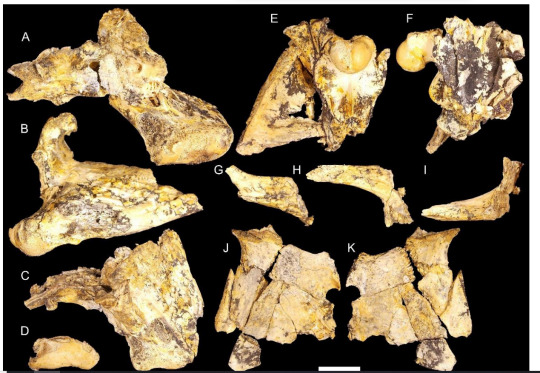
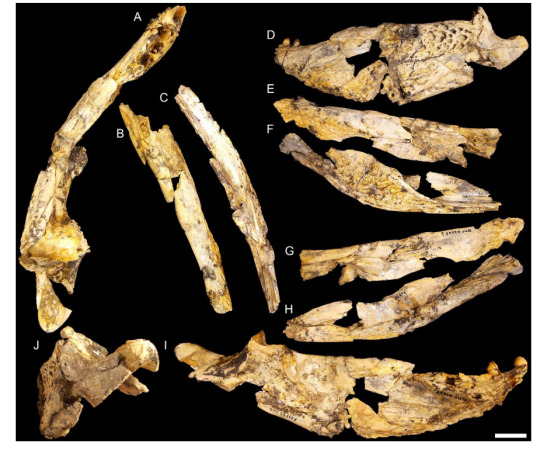
As is apparent both from my recon and the mandible, the lower jaw of Ultrastenos constricted weirdly rapidly, broad at the back and yet narrow towards the front (thus its name, which just means "extremly narrow").
A key issue here is that we don't know how long the rostrum was. We only have it up to the fourth-last tooth, so how long the snout would have continued we don't know. The idea that the snout was short has been entertained, but is deemed unlikely given that the mandible is very shallow. This would instead be more in line with long-snouted animals like gharials.
Size is another point of question. The type material is very small, only about two meters is what I recovered and the paper notes it's "only about as big as a freshwater crocodile", which matches fairly well I'd say. But it is not known whether or not the specimen was actually an adult, so we may find larger individuals in the future.

Which brings us to the disclaimer.
In 2023's "Migrations, diversifications and extinctions: the evolutionary history of crocodyliforms in Australasia", the confusion and uncertainty of Ultrastenos is once more brought up. Some of what is written is what you'd expect, which is that it's enigmatic and the interpretations of Stein et. al. need more research. Logical so far, its undeniably fragmentary and the interpretation is undeniably speculative. The fact that its phylogenetic placement among mekosuchines is a mess is likewise not a surprise. The original tree differs A LOT from more recent results, while the only other tree that included Ultrastenos is that of Rio and Mannion, which I generally avoid personally.
But the interesting nugget is that apparently, a close relative has been found since then which might have a big impact. But this research is still in prep courtesy of Adam Yates (who I've been told will publish the description of the Alcoota Baru soon enough). So will my recon become obsolete? Probably. But I'll update it accordingly once the time comes.

But lets briefly let go of safety and scepticism and consider the possibility that it really was a long-snouted mekosuchine. Aside from some of the anatomical clues like the shallow mandible, sameish teeth and narrow snout, a longirostrine croc would be expected, from the region, would it not? After all, long snouts evolved many times separately in crocs and despite having an incredibly diverse croc fauna, Australia is shockingly lacking in those. The only examples currently known are the Miocene Harpacochampsa, the Pliocene to Pleistocene Gunggamarandu and the current freshwater crocodile. The former two are gharials the later a crocodylid.
Furthermore, the White Hunter Site, if you remember prior posts, was positively teeming with mekosuchines of all different niches. Large semi-aquatic predators like Baru, small semi-aquatic ones like "Baru" huberi and terrestrial forms like Mekosuchus and Quinkana. So to fit in, Ultrastenos must have done something differently, and conveniently a longirostrine nische is still open. So why not.
Illustrations by Joschua Knüppe and Ashley Patch
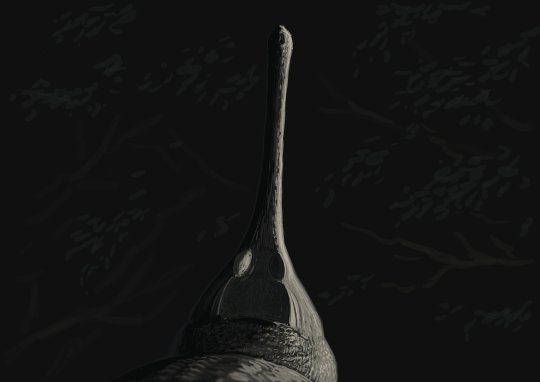
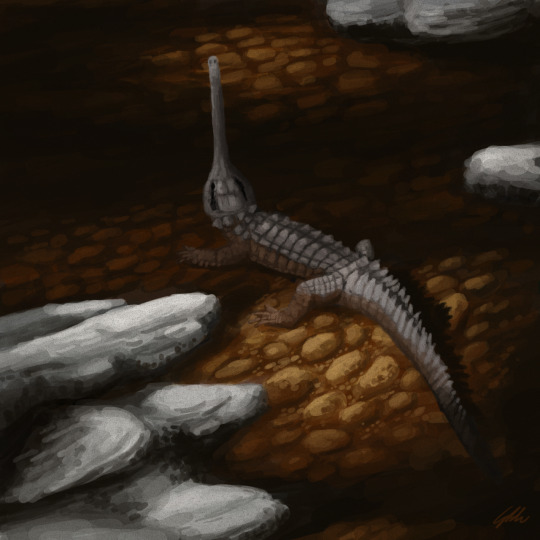
So that's it. Ultrastenos, the enigmatic, possibly longirostrine mekosuchine of the Riversleigh. Will this post age badly? Maybe, maybe not, we'll see.
Wikipedia: Ultrastenos - Wikipedia
Primary sources:
Stein, Michael; Hand, Suzanne J.; Archer, Michael (26 May 2016). "A new crocodile displaying extreme constriction of the mandible, from the late Oligocene of Riversleigh, Australia". Journal of Vertebrate Paleontology. 36 (5): e1179041. doi:10.1080/02724634.2016.1179041
Ristevski, J.; Willis, P.M.A.; Yates, A.M.; White, M.A.; Hart, L.J.; Stein, M.D.; Price, G.J.; Salisbury, S.W. (2023). "Migrations, diversifications and extinctions: the evolutionary history of crocodyliforms in Australasia". Alcheringa: An Australasian Journal of Palaeontology: 1–46. doi:10.1080/03115518.2023.2201319. S2CID 258878554
#palaeoblr#croc#prehistory#crocodile#paleontology#mekosuchinae#long post#ultrastenos#oligocene#riversleigh
22 notes
·
View notes
Note
About Kambara.
While the implementation is sloppy, isn't it still good to have minority languages represented in academia? And isn't it not that unusual to have a repetitive binomial, like with Crocodilus suchus as you've shown or Gorilla gorilla and the like?
Sorry if I sound a bit standoffish. Usually, complaints about nomenclature containing indigenous or other minority languages ping my suss radar, and I don't want folks to be encouraged to dismiss attempts at inclusion in science. Not that I think you were intending that, I mostly felt like as far as taxonomic names go, there can be far worse.
Rest assured that the post was meant to be somewhat tongue and cheek. I don't carry any ill will against Kambara taraina or the naming of it, rather I simply find it quite humerous that the authors went out of their way to make a redundant scientific name (which isn't as typical in fossil taxa as it is in modern ones), regardless of which language they chose to convey it in.
Kambara is definitely a great name and it goes along nicely with several other Australian crocodilians having been given names derived from indiginous languages.
Mekosuchus for example derives from Mek, the Drehu name of Grande Terre
Gunggamarandu combines Barunggam and Wakka Wakka words to mean "river boss" (which funnily enough is kind of just an alteration of Paludirex's name meaning swamp king)
Baru and Quinkana, two other iconic names imo, both derive their meaning from Dreamtime stories.
It's definitely a trend I hope to see continued, perhaps even with "Baru" huberi which is most likely in need of a distinct genus name anyways.
Outside of Australasia you also have stuff like Tsoabichi (from Shoshoni for monster), Voay (another instance of just crocodile but this time in Malagasy), Gnatusuchus (latinized Quechua for nose) and Kuttanacaiman (again from Quechua for cutting/grinding machine) to name a few.
4 notes
·
View notes